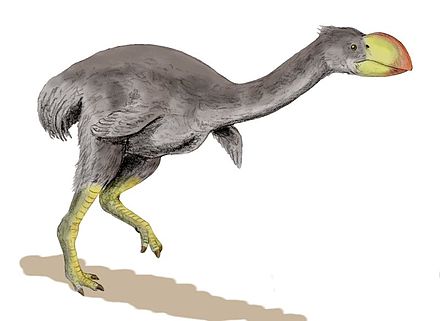Ambiortus
| Ambiortus Temporal range: Early Cretaceous,
| |
|---|---|
| Scientific classification | |
| Domain: | Eukaryota |
| Kingdom: | Animalia |
| Phylum: | Chordata |
| Clade: | Dinosauria |
| Clade: | Saurischia |
| Clade: | Theropoda |
| Clade: | Avialae |
| Clade: | †Ambiortiformes |
| Family: | †Ambiortidae Kurochkin, 1982 |
| Genus: | †Ambiortus Kurochkin, 1982 |
| Species: | †A. dementjevi
|
| Binomial name | |
| †Ambiortus dementjevi Kurochkin, 1982
| |
Ambiortus is a prehistoric bird genus. The only known species, Ambiortus dementjevi, lived sometime during the Barremian age between 136.4 and 125 million years ago[1] in the Andaikhudag Formation of Mongolia. It was discovered by Yevgeny Kurochkin in 1982.[2]
Classification
Ambiortus dementjevi belongs to the Ornithuromorpha (the group containing modern birds but not enantiornithes), according to all published cladistic analyses. However, the exact position of the species within this group has been controversial. Early studies suggested it was a member of the Palaeognathae, the group containing modern ratites and Tinamou,[3] but this has not been supported by later research. Some studies have found it to be closely related to the Ichthyornithes, a relatively derived group closely related to modern birds.[4] However, most analyses have found it to be either an unresolved member of the Ornithurae, or a more basal member of Ornithuromorpha. One 2006 study, for example, found it to be more primitive than Yanornis but more advanced than Hongshanornis, or even a member of the specific group containing both Yanornis and Yixianornis.[5]
The family Ambiortidae is sometimes used for this genus, especially if it is considered a close relative of the much younger Apsaravis.[6] The results of a cladistic analysis published in 2011, on the other hand, indicate that at least Apsaravis and Palintropus (which was mistaken as a much more modern bird initially) are very closely related.[7]
References
- ^ Holtz, Thomas R. Jr. (2012). Dinosaurs: The Most Complete, Up-to-Date Encyclopedia for Dinosaur Lovers of All Ages, Winter 2011 Appendix (PDF).
- ^ Chiappe, L.M.; Witmer, L.M. (2002). Mesozoic Birds: Above the Heads of Dinosaurs. University of California Press. p. 350. ISBN 9780520200944. Retrieved 2015-08-20.
- ^ Kurochkin, (1985). "A true carinate bird from Lower Cretaceous deposits in Mongolia and other evidence of Early Cretaceous birds in Asia." Cretaceous Research, 6: 271-278.
- ^ Kurochkin (1999). "The relationships of the Early Cretaceous Ambiortus and Otogornis (Aves: Ambiortiformes)". pp. 275-284 in Olson (ed.), Avian Paleontology at the Close of the 20th Century: Proceedings of the 4th International Meeting of the Society of Avian Paleontology and Evolution. Smithsonian Contributions to Paleobiology, 89.
- ^ You, Lamanna, Harris, Chiappe, O'Connor, Ji, Lu, Yuan, Li, Zhang, Lacovara, Dodson and Ji, (2006). "A nearly modern amphibious bird from the Early Cretaceous of Northwestern China". Science, 312: 1640–1643.
- ^ Mortimer, Mickey (2011): The Theropod Database: Phylogeny of taxa Archived 2013-05-16 at the Wayback Machine. Retrieved 2013-03-02.
- ^ Longrich, N.R., Tokaryk, T., and Field, D.J. (2011). "Mass extinction of birds at the Cretaceous/Paleogene (K/Pg) boundary". Proceedings of the National Academy of Sciences, 108 (37): 15253-15257. doi:10.1073/pnas.1110395108.




.jpg/440px-Archaeopteryx_lithographica_-_Pedro_José_Salas_Fontelles_(flipped).jpg)




